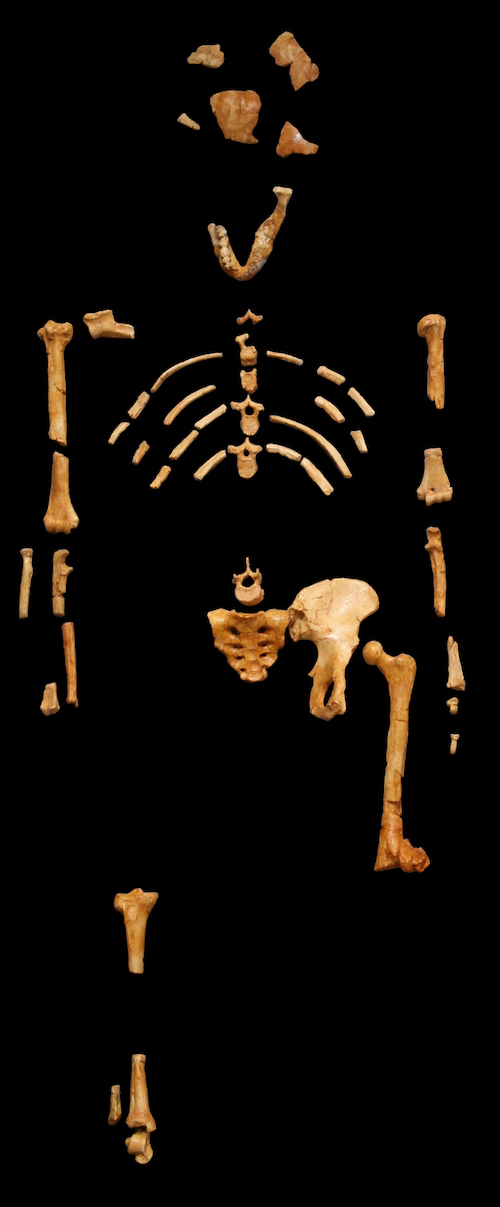 Evolution
Evolution
 Human Origins
Human Origins
Honoring the 41st Anniversary of the Discovery of “Lucy,” Google Offers a Misleading Doodle

Yes, it’s the 41st anniversary of the discovery of “Lucy.” Google has a cute Doodle in her honor:

However, back in 2009, Casey Luskin made a pilgrimage to see the lady’s bones, then on display at the Seattle Science Center. He wrote here at Evolution News:
The whole experience seeing Lucy was enlightening, though probably not in the way its creators intended. In short, I left the exhibit struck by the paucity of actual hard evidence for human evolution from ape-like species, and the amount of subjective, contradictory interpretation that goes into fossil hominid reconstructions.
“Lucy” was discovered by paleoanthropologist Donald Johansen and his team in Ethiopia in 1974. The first half (or more!) of the exhibit was actually quite fascinating as it told the cultural and political history of the Ethiopian people and the Aksumite Empire. This history seemed well-documented by facts and evidence, replete with coins, weapons, religious artifacts, and art, which inform us about this rich and beautiful culture. And when the evidence was thin, the exhibit acknowledged that there are aspects of the Aksumite people where we know very little. This high standard of evidential documentation and appropriate tentativeness disappeared, however, as soon as we entered the section of the exhibit dealing with human evolution.
Lucy in the Dirt with Rock Rubble
The first thing my friends and I noticed when seeing Lucy’s bones was the incompleteness of her skeleton. Only 40 percent was found, and a significant percentage of the known bones are rib fragments. Very little useful material from Lucy’s skull was recovered. (This seems to be common: many of the replica skulls of early hominids at the exhibit were clearly based upon extremely fragmentary pieces.) And yet, according to the exhibit, Lucy still represents the most complete pre-Homo known hominid skeleton to date.
Not only was I underwhelmed by the incompleteness of Lucy’s skeleton, but I was also struck by admissions at the exhibit that, in my mind, cast serious doubt on whether we know for certain that Lucy’s bones are from a single individual from a single species.
On the issue of whether Lucy walked upright, as the Google Doodle misleadingly implies:
As noted, the most interesting part of Lucy’s skeleton is her half-pelvis and half-femur that were discovered, which are said to indicate that she walked upright. Thus, despite these nagging questions about the integrity of Lucy’s skeleton, the exhibit boldly states that “Lucy’s species walked bipedally, in much the same way as we do,” at one point saying Lucy’s skeleton “approximate[s] a chimpanzee-like head perched atop a human-like body.” Of course, this is a gross oversimplification of the data and a poor reflection of the sharply contradicting opinions of many learned paleoanthropologists.
Lucy did have a small, chimp-like head, but as Mark Collard and Leslie Aiello observe in Nature, much of the rest of the body of Lucy’s species, Australopithecus afarensis, was also “quite ape-like” with respect to its “relatively long and curved fingers, relatively long arms, and funnel-shaped chest.” (Nature, Vol 404:339-340, 3-23-00.)
Collard and Aiello’s article also reports that we now have “good evidence” that A. afarensis (including Lucy) “‘knuckle-walked,’ as chimps and gorillas do today.” Due to their evolutionary preconception that Lucy was a bipedal precursor to our genus Homo, they call this plain evidence that Lucy knuckled-walked “counterintuitive.” They suggest the possibility that “the locomotor repertoire of A. afarensis included forms of bipedalism, climbing and knuckle-walking.” This is a tenuous proposal, however, as knuckle-walking is obviously very different from bipedal locomotion. Collard and Aiello suggest avoiding the “counterintuitive” evidence that Lucy climbed and knuckle-walked by discarding it as unused “primitive retentions” from her ancestors.
By ignoring the skeletal evidence that Lucy didn’t walk “bipedally, in much the same way as we do,” I’m sure these Darwinists are pleased that Lucy can retain her prized position as our alleged bipedal ape-like ancestor.
Read the rest. As a monument to human evolution, clarifying the mystery of our origins, Lucy falls well short.
Image credit: 120 (own picture worked with photoshop) [GFDL, CC-BY-SA-3.0 or CC BY 2.5], via Wikimedia Commons.
